Web application development is the process involved with building a web application. It is more focused on interacting with the browser than standard engineering processes. Mobile apps are exclusively made for mobile gadgets. They are more suitable for a specific platform like Android, iOS, and Cross-platform. Web applications, on the other hand, cannot be used without the internet. You can download a mobile app from an app store that acquires space on your device. But, a web application functions in real-time in a web browser with CPU resources.
At Nablasol, we have an approach we follow which varies from project to project. In this blog, we give you the outline of the general procedure used in most software projects.
Here are the steps to web application development
Define the Problem and the Users
Start with a brainstorming session on the drawing board. List out everything that will help you define what you are trying to achieve from the application. Understand the potential users and outline how they will interact with the app.
Establish the Scope of Functionality
List out all the functions that the app will perform. Think of the features of the app and put them in three different pools. These include must-have, good-to-have, and maybe later-versions.
Create a Mockups of Key Features
Build rudimentary screen mockups for all the features of the app. This will help you get a better understanding of what you are building. Enhance your mockups with storyboarding and wireframes.
Devise a Data Model
This is one of the most essential steps in building an app. Make sure you define a cohesive data model. This will enable you to stand the user load without deteriorating the performance. As a result, it will be easy to alter for future enhancements.
Construct A Development Model
Define an appropriate architecture for your app. Break your app down into modules – define coding standards, design patterns, functional outlines, test cases, etc.
Plan on How to Develop & Test
Develop your app and test at each stage of development. Depending on time, you may want to build a prototype before drafting the final version. Once the final version is developed and tested, launch the beta to a select group of users for further testing and feedback.
Prepare for Sudden Changes to Plans
Never make a very firm plan. Your plan should be thorough but at the same time be ready for modifications. Handling changes at every stage should be part of your plan, as almost everything in software design is an iterative process.



